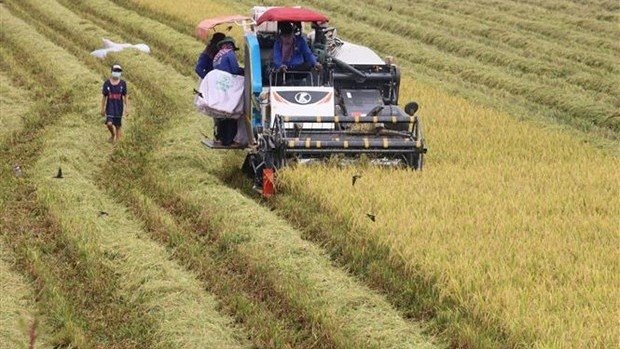Agriculture plays huge role in maintaining social stability: Minister
ABO/NDO – Though growth of agriculture cannot compete with that of industry and its contribution to the economy remains relatively small, it plays a huge role in maintaining social stability, Minister of Agriculture and Rural Development Le Minh Hoan told a press conference on February 17.
The event was held to announce the official launch of the strategy for sustainable development of agriculture and rural areas from 2021 – 2030, with a vision to 2050.
With a long-term vision, the strategy does not only address the sector’s current issues but also keep up with global trends, for example, green consumption, Hoan remarked.
The strategy aims to provide foundation for the sector’s restructuring, he said, stressing agriculture must adopt new ways of thinking to transform the sector from production to economy and to improve products’ value and diversification.
 |
| Rice crop harvest in the Mekong Delta province of Dong Thap. (Photo: VNA). |
The sector is going towards a green agriculture and eco-agriculture through the adoption of advanced technologies and efficient use of inputs and natural resources, without harming the environment and human health, the minister noted.
The strategy for sustainable development of agriculture and rural areas for 2021 – 2030, with a vision to 2050 was approved by Deputy Prime Minister Le Van Thanh earlier this month.
The overall goal is to develop cash crop cultivation based on local advantages; oriented towards high productivity, quality, effectiveness, sustainability, and competitiveness; firmly guaranteeing national food security; and substantially helping with socio-economic stability, natural disaster and epidemic prevention and control, climate change response, and effective implementation of international commitments on greenhouse gas emission reduction.
Among the detailed targets for 2030, agriculture - forestry - fisheries are expected to achieve GDP growth of 2.5 – 3 percent, an increase of 5.5 – 6 percent in labour productivity, and exports rise of 5 – 6 percent each year on average.
Besides, the strategy looks to raise rural residents’ income by 2.5 - 3 folds from 2020, bring down the multidimensional household poverty rate by 1 - 1.5 percent annually, reduce the percentage of agricultural workers to less than 20 percent of the total workers in society, and increase the rate of trained agricultural workers to over 70 percent.
It also targets at least 90 percent of the communes nationwide recognised as new-style rural areas, environmentally friendly agriculture adapted to climate change, and greenhouse gas emissions down 10 percent from 2020.
(Source: NDO)
 về đầu trang
về đầu trang







